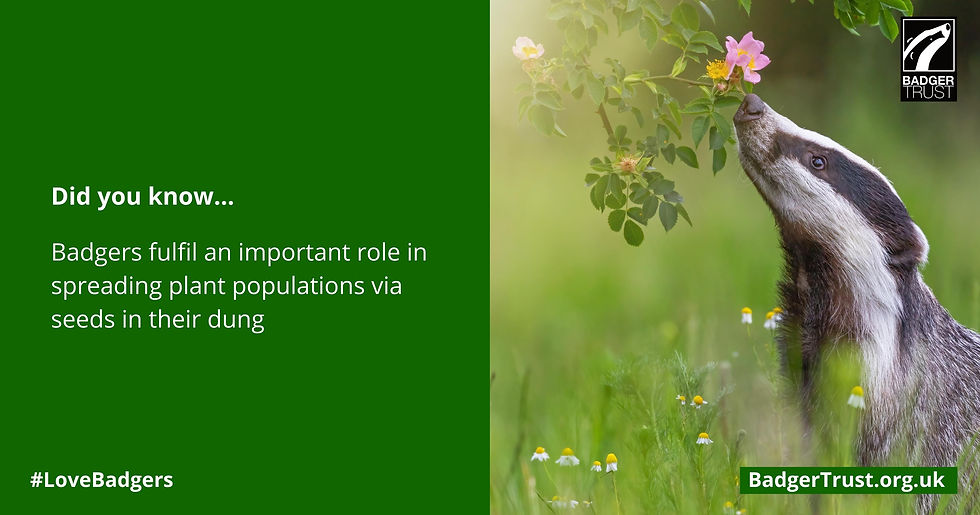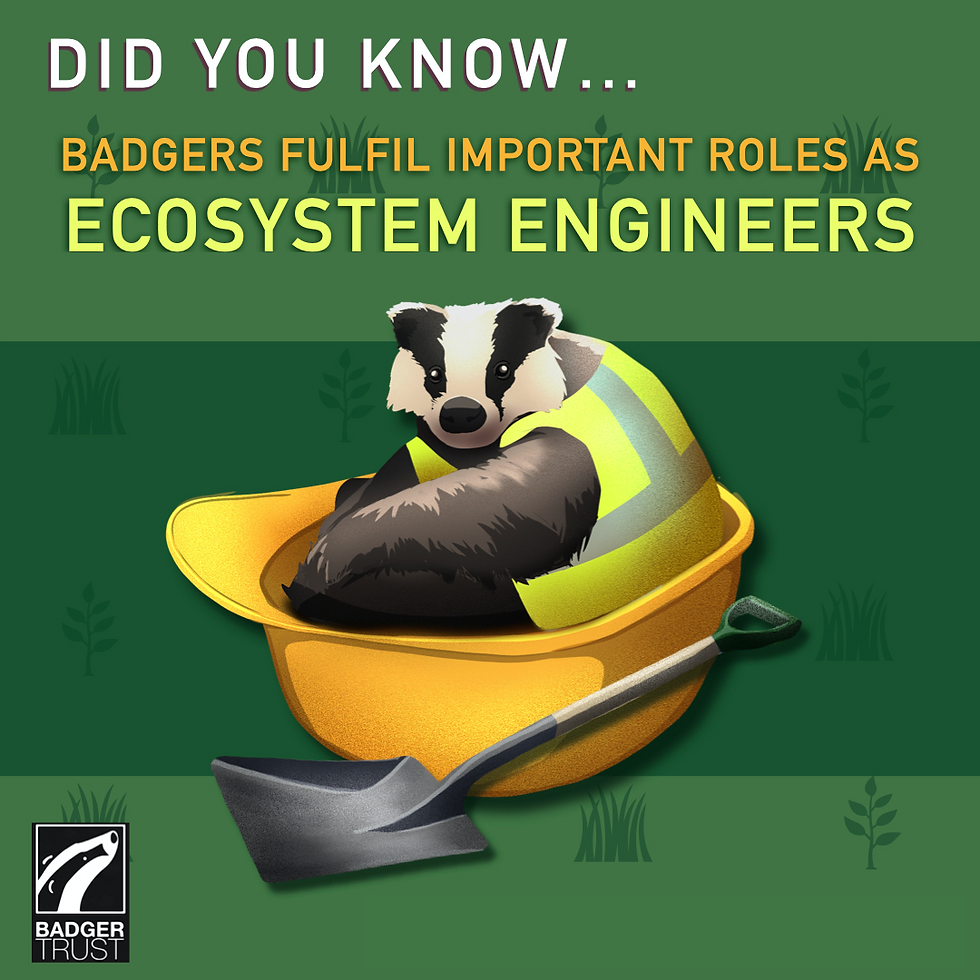Garden tips for living alongside badgers
- Badger Trust Staff Team

- Jun 20, 2022
- 4 min read
How creating safe spaces for the UK’s iconic native mammal helps to keep the species and our ecosystems healthy.
Badgers are iconic mammals, and we are lucky to have them around in this country. They are amazing creatures but, being nocturnal, there is less known about them than some other animals.
Badgers and their setts are protected, and disturbing them is illegal. Living alongside these native mammals, it's worth bearing in mind that badgers are wild animals with a strong connection to their territories and special areas. Badgers are a central part of the ecosystem and have a key role in seed dispersal through their dung. Like many animals that eat fruit, their faeces help plant the seeds further from the host plant and provide nutrients for the seed to grow.

If you can, creating safe areas for displaced wildlife helps to keep the species and their ecosystems healthy. So if you have a sett in your garden, the easiest thing to do is be patient and enjoy watching these key ecosystem engineers at work.
Badger Trust, the leading voice for badgers in England and Wales, always encourages creating more space for wildlife and healthy ecosystems. So if you have badgers in your garden, consider yourself lucky to have such iconic wildlife; it’s a sign of a healthy ecosystem. Perhaps put up a wildlife camera so that you can watch badgers doing their natural behaviour and foraging for food; it can be fascinating.

Many people enjoy having badgers visit their garden. But as wild animals who don’t recognise things like ‘gardens’ or understand fences or boundaries, they can present challenges to homeowners.
With their incredible sense of smell, badgers find food where they can. Often unseen and unheard, they wander quietly into gardens at night, feeding on the earthworms, grubs, snails and slugs they find in lawns and borders. They usually leave small visual signs – a snuffle hole or pieces of scratched turf – as visible evidence of their nighttime visit. In dry or frosty conditions, when natural food is hard to come by, they can damage flower beds and lawns in desperate search of food.
As a rightly protected and wild animal, you are limited in what you can do, but usually, it is possible to reduce garden damage without harming badgers.
Often damage is seasonal, and you may see periods of greater activity in the late autumn (as badgers prepare for the winter) and spring (when badgers have cubs). If you can be patient, the badgers will often become less active at different times of the year.
A badger’s primary food is earthworms, which they will suck from the surface like spaghetti, so they are unlikely to cause any damage. However, if they are digging into the lawn, they are probably looking for insect larvae beneath the roots of the grass, especially from Cockchafer beetle (May bug) and Leather Jacket (Cranefly). The season for grubs is relatively short-lived, and raked and well-drained lawns will help reduce the burden. You can also try removing weeds, scarifying dead moss, improving drainage or applying nematodes to help stop larvae from taking up residence in your lawn, where they will damage the grass root structure before the badgers ever snuffle them out.
Feeding the badgers or putting out food for other wildlife (including bird feeders) will also increase activity.
Badgers are strong, determined animals and excellent diggers. Badgers will always use the same tracks for generations. When areas are constantly fragmented by new development, foraging ranges become restricted, causing them to find alternate routes to access their familiar territory. If a badger is breaking fencing, you may want to consider installing a badger gate, or leaving a gap, so they can pass through your garden without damaging the fence. For these to be effective, they should be positioned at a badger trail, i.e. the route the badger uses.
You can contact your local badger group for advice on how to help with badgers in your area.
Watch ecologist and Shropshire Badger Group’s Tris Pearce share his top tip for dealing with badgers in gardens
Give badgers a brake
Finally, look out for dead and injured badgers when you are out and about. Road accidents kill thousands of badgers every year, so please report badger deaths to us. If the victim is a lactating female (swollen teats on a badger sow, January to June), your local badger group may be able to help the cubs. In all cases, it helps us build up knowledge of badgers to protect them in the future.
Our Mission
Our mission is to promote and enhance the welfare, conservation and protection of badgers, their setts and their habitats.
Our Vision
Our vision is a world where badgers are respected as part of our rich wildlife heritage, safe from persecution
How you can get involved in badger protection
Badger Trust is a small charity that is 100% funded by voluntary donations from local badger groups, supporters, and members of the public. We can't do any of our work without financial and campaign support from people like you. Getting involved with your local group and signing up for a monthly donation plan with the Badger Trust are two of the best ways you can help preserve this wonderful species for generations to come.



